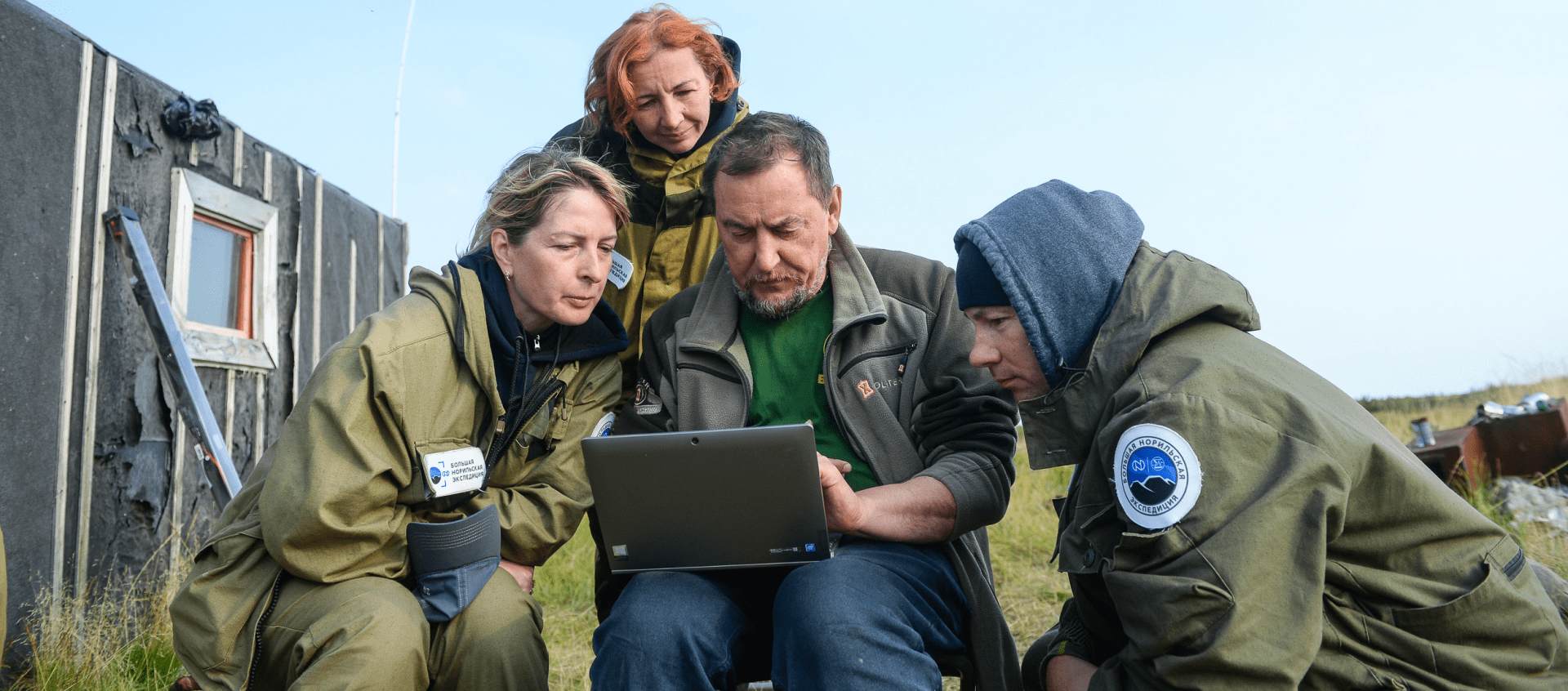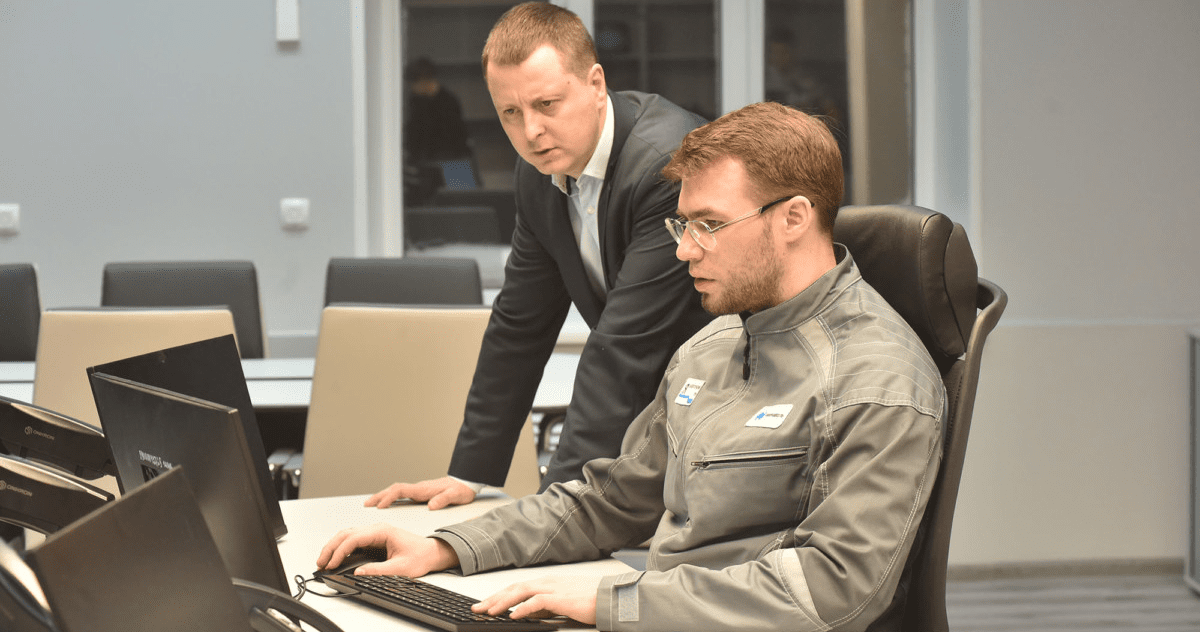Digital technology development
Nornickel’s contribution to the Data Economy and Digital Transformation of the State national project
Relevant UN SDGs
Related federal projects
Internet Access Infrastructure
Domestic Solutions
Artificial Intelligence
Cybersecurity Infrastructure
Nornickel’s key initiatives and focus areas
Integration of digital tools across Nornickel’s operations contributes to the streamlining of business processes, ensures safety and continuity of operations at the Company’s assets and units, and enables prompt data analysis and timely management decision making, ultimately enhancing the quality of life for local communities in its regions of operation.

Ensuring technological sovereignty

Nornickel’s objective is to enhance the effectiveness of IT solutions through participation in their development. By collaborating with domestic IT vendors, we strive to maintain agile control over IT product development and mitigate risks to business processes through the prioritisation of Russian software solutions.
Liana Ermishina, Vice President for Information Technology
Approach to corporate IT architecture
Given its focus on ensuring the stability and reliability of the IT landscape, as well as compliance with regulatory requirements, the Company systematically selected domestic alternatives and approaches to replace imported solutions across all layers of its IT landscape throughout 2024.
A number of domestic products were successfully piloted, specifically pilot implementations of backup and virtualisation systems were completed. A key milestone in the reporting year was the completion of the selection process for target solutions across all infrastructure applications and software projecting the corporate image. A standard operating system for user workstations was established for the Group, and a prototype corporate IT image was developed. The implementation of a pilot to migrate users to the Linux‑based infrastructure is planned in the short term.
Increasing the technological independence of IT infrastructure
Ensuring technological independence of industrial automation systems
In 2024, the Company:
- expanded the software and hardware of its automated process control system (APCS) testing laboratory
- updated the list of programmable logic controllers (PLCs) and SCADA systems
- strengthened the methodological support for the Company’s APCSs, specifically:
- updated the methods used to define technical requirements for APCS components and supporting documentation
- is developing methods for classifying industrial automation systems and implementing emergency protection for hazardous facilities
- under the supervision of the Russian Ministry of Industry and Trade and with the involvement of in‑house experts, continues to work on technical requirements for specific components of an open APCS to meet the needs of production units
- developed requirements for an open‑software PLC and an open integrated development environment.
Complying with legal requirements to move critical information infrastructure facilities to trusted hardware and software
In 2024, Nornickel launched a programme to transition the Group’s critical information infrastructure facilities (CIIFs) to the priority use of trusted hardware and software solutions (HSSs).
In the reporting year, the Company, through joint efforts of its relevant functions, managed to systematise its CIIF‑focused initiatives. This included legislative monitoring, updating CIIF information for the Federal Service for Technical and Export Control, and developing plans around transitioning CIIFs to trusted HSSs. Furthermore, we are collaborating with government agencies on enhancing the regulatory framework with a view to accounting for objective factors that necessitate extending the use of the existing equipment fleet.
DevSecOps platform
Nornickel is enhancing its DevSecOps (DSO) platform to integrate the development, operations, and information security processes, enabling standardised and automated secure software development. The platform serves as a single source for storing, downloading, and verifying source code and as a trusted repository for dependencies.
In September 2024, the DSO platform went live. A conceptual design for integrating ML application development (MLOps) and secure development was also completed. The number of projects implemented on the platform more than tripled over the reporting year.
DevSecOps project implementation effects
Accelerated release of updates, improved software quality and security, and quick adaptation to changes
Reduced costs for regulatory compliance, development, and acceleration of software delivery processes in line with circular programming approaches
Support for import substitution in the IT sector
Enhanced employee skills through training in DSO methodologies, stronger information security expertise of IT specialists, and improved team productivity
The platform promotes sustainable software testing through automated testing, virtualised test environments, and continuous integration and delivery.
Project development plans for 2025 and beyond:
- expand functionality and connect new development teams to the platform
- establish network integration with segments deployed at the Company’s remote branches
- enable generation of DSO‑based reports on team performance metrics
- upgrade dashboards to track platform performance
- elaborate the concept for integration with the corporate hybrid cloud platform
- develop security templates to speed up development processes
- create a knowledge base of information security settings
Developing industry‑specific solutions within the framework of industrial competence centres
During 2024, the core functionality of the Magma suite of IT products was under development and subsequently showcased at multiple industry exhibitions, including Smart Mining & Metals, Minex, and CIPR. A site was also selected for testing, validation, and feedback collection, scheduled for 2025 in collaboration with the project co-sponsors. The results of the relevant key projects will be submitted to the Russian Ministry of Industry and Trade and the Ministry of Digital Development, Communications, and Mass Media by the end of 2025. Plans for 2026 include launching pilot projects at Nornickel and scaling across the industry.
In 2024, a predictive emissions monitoring system (PEMS) was developed to monitor and account for pollutant emissions. The system’s operation relies on digital twins of production processes.
Testing of the Axioma software was conducted at the Norilsk production site towards the end of the reporting year. The tests aimed to assess the consistency of outcomes from Axioma mathematical models, accredited laboratory sample analyses, and real‑time instrumental readings from certified gas analysis equipment. The measurements were conducted in accordance with metrological standards, under supervision of the Mendeleev All‑Russian Institute for Metrology (VNIIM).
Based on the results of the tests conducted by Rostest, a recommendation by the State System for Ensuring the Uniformity of Measurements was registered.
A certificate of compliance was also received from an accredited centre, confirming that the Axioma software meets the requirements for AI‑based measurement instruments.
Within the ICC project portfolio, this project is among the most important and prioritised. The solution was showcased at numerous all‑Russian exhibitions and forums and received a number of awards (for more details on the awards, please see the Awards appendix).

IT infrastructure and communications for employees and local communities in the regions of operation
Maintaining IT infrastructure reliability
The Company’s wealth of in‑house IT expertise and its collaborations with technology partners contribute to the mitigation of IT infrastructure and system software failure risks associated with the unavailability of updates from Western vendors or shortages of spare parts and components for foreign‑made IT equipment.
A corporate monitoring system for IT infrastructure and business applications is a key tool designed for proactive prevention of IT incidents.
Efforts are ongoing to upgrade the corporate data network at key Russian business units. A number of facilities in Norilsk have been equipped with modern IT infrastructure built entirely on domestically manufactured network hardware, ensuring, among other things, compliance with applicable regulatory requirements. In 2024, a project to deploy a trunked radio network meeting high standards was completed.
Development of the Moscow enterprise data centre cluster
In 2024, the Company completed the relocation of the Group’s IT capacities and information systems to its new data centre. The high level of fault tolerance offered by the corporate IT infrastructure has enabled the seamless migration of approximately 268 physical servers, over 300 virtual machines, and more than 200 business‑critical information systems and services without materially impacting business processes or significantly disrupting information system availability.
Leveraging cloud IT infrastructure
Since 2022, the Company has been using public cloud services which offer increased development speed and convenience, enable rapid scaling to match project needs, reduce the workload on operational staff, and optimise overall costs.
In the reporting year, the Company conducted an in‑depth analysis of the market for private cloud solutions offered by Russian vendors and developers. Some products underwent testing for compliance with the Company’s functional and information security requirements.
In 2025, the Company plans to leverage a secure and resilient communications channel, protected by information security tools, between its corporate network and a public cloud environment to start migrating non‑critical information systems to a cloud landscape, which will enable it to optimise CAPEX for import substitution initiatives.
Improving IT infrastructure reliability at Norilsk Airport
To ensure the uninterrupted operation of IT infrastructure at Norilsk Airport, its upgrade was launched in 2023. The project will be delivered using domestically produced equipment and software. In the reporting year, an internal audit of the airport’s information systems was conducted, and the technical requirements for the server room upgrade project were defined. Implementation of engineering solutions to ensure the continuous operation of IT infrastructure and APCS equipment is scheduled for 2025 and 2026.
Fibreoptic communication line in the Norilsk Industrial District
In the reporting year, as part of the 981‑km fibreoptic communication line (FOCL) project along the Novy Urengoy–Norilsk route, several expansion initiatives were implemented, including:
- completion of a project to ensure IT and business continuity along the Dudinka–Norilsk–Talnakh section. To achieve this, 359 km of fibre were installed along the railway lines of the Polar Division’s industrial railway transport operator, thereby providing stable connectivity to 38 production sites of the Polar Division
- commissioning of the Igarka–Vankorskoye deposit route section and the completion of work to ensure full FOCL redundancy. The Novy Urengoy–Norilsk telecommunications network section was fully switched to backup cable redundancy mode, preventing communications outages due to incidents on line sections. The communications channel maintained 99% availability, with emergency recovery times not exceeding 72 hours.
Automation of Nornickel’s core and auxiliary business processes
Transport planning and management system (SPRUT)
SPRUT is a tool designed to automate transport management processes, matching transport customers and service providers.

In 2024, the development of the system’s core modules was completed, functional testing was carried out, and compliance with customer requirements was confirmed. The system was implemented and rolled out across Polar Division enterprises in response to high demand.
At the initial stage, the SPRUT system is designed to monitor road transport operations only. Further development will extend its capabilities to cover the planning and tracking of rail and water transport. This functionality will support the transition to multimodal chain planning.
The SPRUT system is scheduled for commercial deployment in December 2025.
Automated system for mining data processing and analysis
The Company has continued to implement a project to build a unified digital platform facilitating endto-end automation of core business processes across a mining enterprise. The selected system was sourced from a Russian developer and is currently being customised to meet Nornickel’s requirements.
In 2024, functionality was implemented to enable the recording of mine planning and design data and the management of mine surveying calculations. In addition, a functionality was designed to automate planning and execution of geological exploration activities, geological modelling and calculations, and mineral reserve tracking.
The system will secure the quality, availability, and accuracy of production data across all levels of the Company, enabling timely and effective management decision making.
Measurement consistency
A working group was formed to develop a methodology for determining whether measuring instruments fall under state regulation. In the reporting year, the group reviewed the existing algorithm and identified the list of additional information required to assess whether mandatory calibration is needed due to the instruments being subject to state regulation. The Company intends to continue this effort to assess the accuracy of determining whether mandatory calibration is required for measuring instruments across all its production sites and Russian business units.
Automated system for monitoring compliance with the Golden Rules of Safety
The project is aimed at creating an automated system for monitoring compliance with industrial safety rules, powered by computer vision.
The implementation of this system will reduce work-related injury rates caused by violations of H&S requirements, provide 24/7 monitoring of compliance with the Golden Rules of Safety in areas that are difficult to access for real-time supervision, and reduce equipment downtime caused by accidents.
In December 2024, the prototype was successfully tested at Severny Mine. The tests achieved the performance targets for automated detection of H&S violations.
Precise personnel positioning system at mines
In 2024, the implementation of a precise personnel positioning system was completed across Komsomolsky, Oktyabrsky, Mayak, Skalisty, and Taimyrsky Mines. Enabled by technical solutions, a collision avoidance system was implemented on self-propelled diesel machinery to alert the operator of potentially hazardous proximity to pedestrians and other vehicles. The further enhancement of this functionality included the design and implementation of an automatic braking and stopping system for self-propelled vehicles, enabling the vehicle to stop in dangerous situations.
The project is aimed at enhancing the safety of employees working in the hazardous operational environment of the mine. The system not only enables emergency notification of personnel but also helps determine their location and reduces response time for rescue services during emergencies. In addition, the solution includes features such as employee immobility detection, alerts for hazardous proximity to vehicles, and access control for hazardous areas.
Further project development is planned, including features such as managing safe routes for personnel underground movement from the lamp room to their workplaces and a mobile solution for mining supervisors, designed to improve the speed of production process management without involving the mining dispatcher.
Protecting facilities from potential threats
To enhance the protection of facilities against potential fire hazards and to comply with the federal standards and rules of industrial safety, specifically the Safety Rules for Mining and Processing of Solid Minerals, the Company initiated projects to retrofit underground facilities with automatic fire extinguishing systems.
Rapid Hazard Identification service
As part of its digital transformation of health and safety, the Company is deploying modern technologies and tools. One such innovation is the launch of the Rapid Hazard Identification service. This service runs on the Supernika corporate mobile application and the Control. Management. Safety automated system. Following a successful implementation at the Kola site, the service is scheduled for testing at the Norilsk site in 2025. The service is designed to provide timely and immediate hazard alerts. Identifying the hazard, taking a photo, and completing a few simple data entry steps in the Supernika application is now all that is required. A designated service administrator assigned by the unit will process the information and take appropriate action.
Enterprise resource planning (ERP) systems
As part of the automation and development of core processes, all key financially significant Group enterprises are included into the unified business template and relevant automation systems, with the groundwork laid to further increase the maturity of related business processes and improve their operational efficiency.
Nornickel is expanding the ERP system’s process coverage to reflect new legal requirements, modifications to its production chains, changes in organisational structure, and new targets aimed at enhancing business process efficiency and capturing economic benefits — all while taking into account sanctions and budgetary constraints. Moreover, efforts are underway to improve data quality and reliability within the ERP system. These initiatives include the development of process performance metrics to identify areas requiring user support or additional training, and the analysis of accumulated historical documentation, followed by large-scale updates. In 2024, this work was carried out across all units of a production enterprise at the Norilsk site, covering the end-toend supply chain from needs identification through to write-offs.
Digital Treasury
In 2024, Nornickel started using the Transit 2.0 Russian multibanking platform to ensure real-time exchange of electronic documents with banks.
Furthermore, in the reporting period, the Company launched the design phase of the Unified Treasury Solution information system. This initiative aims to create a dedicated workstation for treasury experts, providing them with access to realtime liquidity data and advanced analytical tools, which will enhance planning accuracy and increase transparency into cash flows and financial transactions.
In addition, the processes for checking supplier reliability and monitoring delivery timelines for materials and services were streamlined. At the same time, enhancements were implemented to simplify operations through the SRM platform, thereby increasing its appeal to suppliers.
Tax monitoring
In 2024, a comprehensive solution for tax monitoring was implemented to facilitate the publication of Group reports through a data mart by integrating with the Nalog-3 AIS for all key tax categories. The solution was scaled across ten Group enterprises (spanning from the Kola Peninsula to the Trans-Baikal Territory). The implementation of this project facilitated real-time monitoring of almost all Group transactions, reducing the number of audits, document requests, and cutting risk closure time.
This comprehensive tax solution received the Project of the Year 2024: Finance Automation award, which underscores the Company’s digital leadership, inspires innovation, and strengthens its position in the fintech sector.
Corporate data management
To optimise planning and improve the efficiency of production business processes, a heuristic model for generating planned metal balances at concentrator sections was developed on the Russian-made Knowledge Space platform. Testing of two scenarios was completed, and technical documentation was finalised for the Concentration module as part of the Nornickel Group’s Production and Economic Planning System Implementation project. The system will cut production programme preparation time by a factor of three (from 12 weeks to 4) and extend the planning horizon to 42 months, enabling more agile responses to external challenges and changes in business environment factors.
In addition, the containerisation of the corporate data warehouse (CDW) was implemented using domestically produced software: CDW data tiering by functional area was brought into commercial operation, and work is ongoing to apply data tiering to consolidated reporting. This will ensure continuous, high-performance operation of the current CDW solution in the context of growing volumes of corporate data.
Digitising HR processes
In less than a year, the Supernika corporate app was adopted by over 80 thousand users across the Company. They have access to the corporate messenger, portal, and employee’s personal account. The application was enhanced with a new Personal Protective Equipment (PPE) service enabling employees at Oktyabrsky and Komsomolsky Mines to access and evaluate PPE information, and to generate PPE request lists without supervisory intervention. The app received numerous prestigious awards, including recognition from TAdviser IT Prize, IT HR Awards, WOW!HR, Employer Brand Summit, HR Impact, HR Brand, and GlobalCIO.
In addition, preparations are underway for the pilot launch of Nornickel’s HR electronic document management system (HR EDMS). The HR EDMS will minimise the use of paper‑based documents, increase the productivity of HR staff, enable the technological unification of business process documentation, and provide the ability to forecast and respond quickly to changes affecting document flows in HR and social business processes.
Throughout 2024, the functionality of core corporate systems and services for Nornickel employees and management was significantly expanded. These improvements are expected to substantially enhance the efficiency of internal business processes, including HR administration, the Golden Rules of Safety, and employee training and evaluation.

Automated software control and management system deployment
The project automates the audit process, enabling the generation of prompt, up‑to‑date, high‑quality, and reliable reports in real time.
The project resulted in the creation of a Russian platform‑based licence management system, which ensures:
- automated collection of information regarding installed and actually used software and features
- report generation based on automated data collection regarding installed software, including the number of actually used licences
- development of operation budgets and licence acquisition cost planning.
Renovating the CADMCS mobile application
The Corporate Automatic Document Management and Control System (CADMCS) mobile application upgrade facilitated uninterrupted mobile document flow for Company managers while ensuring compliance with information security requirements, thus improving the level of agility, productivity, and reliability of mobile document management.
Integrated Document Management programme
The transformation and technological development programme for business process documentation continued in 2024. A key achievement of the reporting year was the transition of all Group enterprises to legally binding electronic document management (EDM). In addition, the volume of automated routine tasks related to accounts payable processing increased, compliance with legal requirements for machine‑readable powers of attorney within the EDM system was achieved, the scope of electronically processed contractual documentation was expanded, and digital signing of work/service orders was introduced.
Deploying intelligent technologies
Data lake ecosystem
Data lake, a scalable platform for storing and analysing data, drives additional synergies by enriching data in external systems with new information. The data lake solution is built using domestically produced Russian products and open‑source systems and consists of four primary components.
In 2024, the Data Platform and ML Platform were launched into commercial operation.
In the short term (2025–2026), ML clusters are scheduled for commercial launch. This will accelerate the implementation of digital production initiatives by removing the need for iterative design and deployment of integration infrastructure, as well as reduce the analytical load on production control and dispatch systems.
Video analytics
During the reporting period, Nornickel expanded the use of video analytics (computer vision) across its production processes in general, and in health and safety routines in particular. As part of this initiative:
- the automated PPE usage monitoring system, developed in‑house, was rolled out at a Norilsk site production enterprise
- the range of detected H&S violations was expanded (working at height, entering hazardous areas around active equipment, and the unauthorised transport of people using machinery not intended for that purpose)
- a mobile computer vision system was created for safety control monitoring and supporting various work processes in areas where fixed surveillance cameras and communications channels are unavailable (testing is scheduled for 2025)
- optical identification of nickel cathode quality was commissioned in the nickel tankhouse at a metals and mining enterprise of the Kola site, enabling the automated sorting of saleable nickel by grade, ensuring appropriate quality premiums, and reducing commercial losses caused by human error
- development continued on a solution for monitoring mining machinery operation via video streams from onboard recorders: modules were created for recognising the actions of roof bolters, boom drills, and fan drills, which enables tracking machinery and equipment utilisation rates, improves oversight of work order completion, and enhances dispatch efficiency in mines.
Engagement with universities
Nornickel, jointly with Central University, launched the AI in Industry partnership master’s programme. As of 1 September 2024, ten individuals enrolled in the Data Science and Data Engineering courses. Over two years of full‑time study, they will acquire the necessary skills to work on projects implementing artificial intelligence solutions. The programme is taught by experts from Central University and Nornickel employees. Training is delivered in person at Central University’s Moscow campus during evening hours.
The programme curriculum teaches students the fundamentals of programming, provides a solid foundation in Machine Learning, Deep Learning, Data Engineering, and MLOps, and explores business process automation, basic automation principles, and the application of artificial intelligence to workshop and production management.
A training grant from Central University, with a RUB 30,000 stipend
An opportunity to take a paid internship at Nornickel and receive an additional grant equal to 50% of the one awarded by Central University